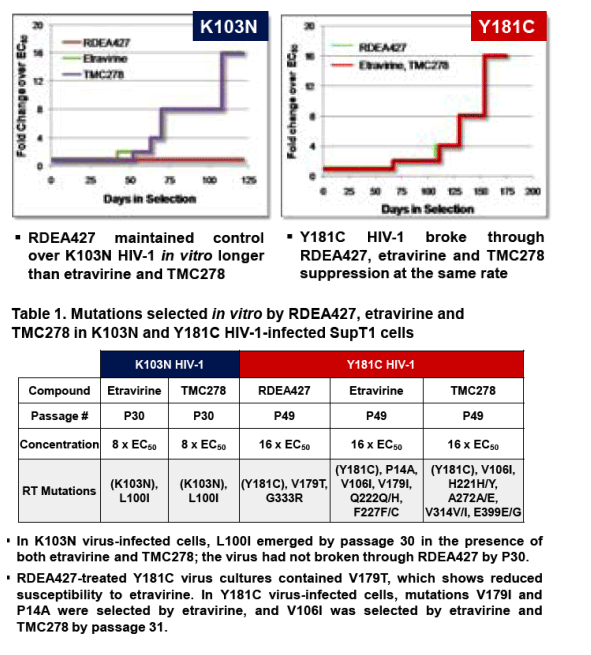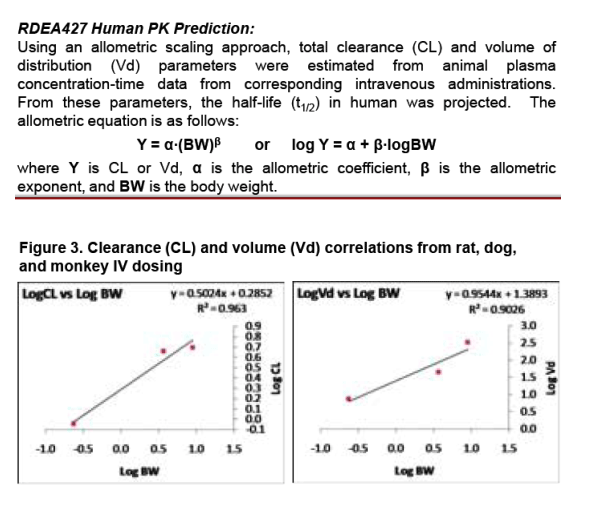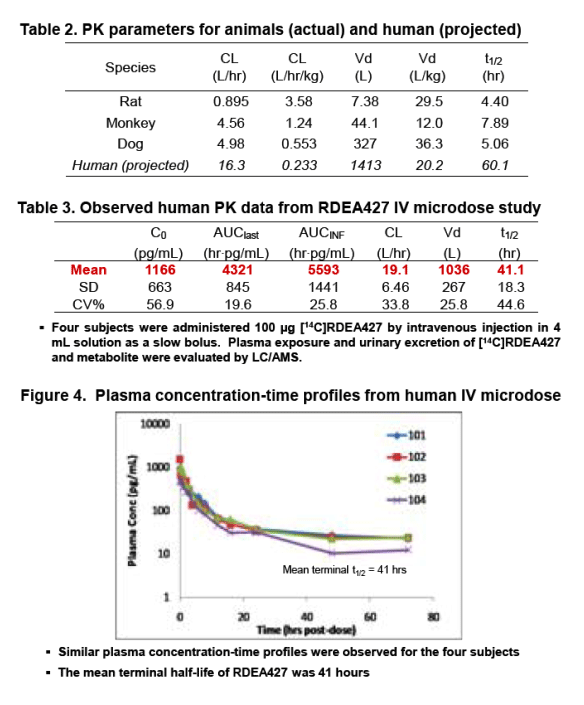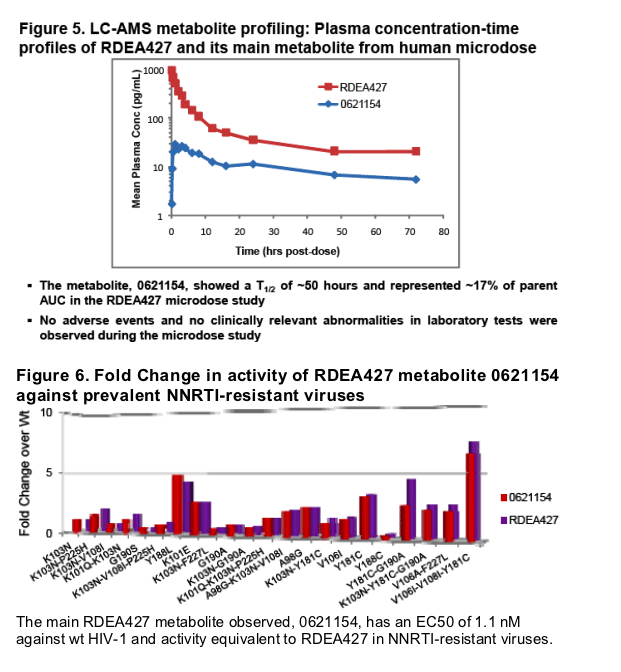 |
 |
 |
| |
In Vitro Resistance Selection Study and Favorable Human Pharmacokinetic Properties of RDEA427, a New HIV NNRTI
|
| |
| |
Reported by Jules Levin
CROI 2009 Feb 8-12 Montreal
Ong1, B Groschel1, Z Shen1, R Straney1, W Xu1, Anneke Raney*1, S Dueker2, JL Girardet1, K Manhard1, and B Quart11Ardea Biosciences, Inc, San Diego, CA, US; 2Vitalea Science, Davis, CA, US
AUTHOR CONCLUSIONS
RDEA is active against NRTI-resistant mutant viruses, including prevalent transmitted viruses and etravirine RAMs.
In vitro selection showed longer suppression of K103N virus by RDEA427 than etravirine and TMC278, suggesting a higher resistance theshld against this virus.
Allometric scaling from rat, dog and monkey projected human clearance and half-life similar to actual values in IV human microdose experiment.
RDEA has a half-life of 41 hours after the IV microdose which would support one daily dosing.
An active metabolite of RDEA427, 0621154, with equivalent activity to RDEA427 in wild-type and NNRTI-resistant viruses, displays about 50 hour halflife.
With its excellent activity against resistant virus, long plsma half-life and lower potential for drug interactions, RDEA427 appears to be a good candidate for future development.
InvitroselectionshowedlongersuppressionofK103NvirusbyRDEA427thanetravirineandTMC278,suggestingahigherresistancethresholdagainstthisvirus.
ABSTRACT
Background: The emergence of resistance to NNRTI limits the efficacy of these drugs. New NNRTI with a higher genetic barrier to resistance and activity against these drug-resistant viruses are needed. RDEA427 exhibits excellent in vitro potency against wild-type and resistant viruses. The results of an in vitro resistance selection study and the favorable human pharmacokinetic properties of RDEA427 are presented.
Methods: Antiviral activities were determined using HIV-1 viruses containing wild-type or NNRTI-resistant sequences. HIV-1 virus resistant to RDEA427 was selected by serial passage in SupT1 cells. At each virus breakthrough, the drug concentration was doubled and the RT region was sequenced for genotypic analysis. Animal pharmacokinetic data were obtained following intravenous administration of RDEA427 and facilitated allometric scaling to predict its half-life in humans. Exposure and urinary excretion in humans were evaluated following intravenous administration of a micro-dose of [14C]RDEA427. Quantitative analysis of [14C]RDEA427 was performed using accelerator mass spectrometry.
Results: RDEA427 had an EC50 value of ~1 nM and retained potent antiviral activity against NNRTI-resistant mutations such as K103N, Y188L, Y181C, K101E, K103N-Y181C, Y181C-G190A, and K103N-P225H. In an in vitro resistance-selection study, K103N virus was controlled by the initial RDEA427 concentration for at least 30 passages. Allometric scaling of clearance data from rat, dog, and monkey intravenous pharmacokinetic studies suggest that RDEA427 possesses potential for once-a-day dosing. This was confirmed in humans, where RDEA427 displayed a mean half-life of ~41 hours and clearance of 0.24 L/h/kg. The presence of an active metabolite, with antiviral activity equivalent to the parent and a half-life of ~50 hours, was also identified and quantified. Mean 24-hour urinary recovery of total radioactivity was 3.8% of the radioactive dose.
Conclusions: RDEA427 has shown potent in vitro activity against wild-type and NNRTI-resistant viruses. In a resistance-selection study, RDEA427 controlled K103N HIV-1 infection for >100 days, suggesting that RDEA427 may provide a high barrier to resistance. Favorable pharmacokinetics of RDEA427 following intravenous micro-dosing in healthy volunteers supports the development of RDEA427, and the long half-life may mitigate the risk of a missed dose.
INTRODUCTION
The widespread use of NNRTIs in ART treatment regimens, while providing greater control of HIV infections, has caused the emergence of RT mutations conferring cross-resistance to most of the NNRTIs currently available. Some of these resistant mutations, especially K103N, have also been transmitted to ART treatment-naives. RDEA427, a new NNRTI in clinical development, has potent antiviral activity against WT HIV-1 and viruses with prevalent NNRTI-resistant mutations. It also retains activity against many of the recently identified etravirine resistance mutations (RAMS). RDEA427 shows a lowr potential for CYP3A4 indution than etravirine and TMC278 and better metabolic stability and lower covalent binding than TMC278.1 An in vitro selection study with RDEA427 I K103N and Y181C HIV-1-infected SupT1 cells suggest RDEA427 will have a genetic barier to resistance similar to or better than etravirine and TMC278. In a human PK microdose study, RDEA427 had a mean half-life of 41 hours, compatible with once-daily dosing.

RDEA has excellent activity (FC<1) against the K103N mutant virus, the most commonly transmitted resistant virus in ART naive patients.
RDEA427 retains antiviral activity against viruses with other prevalent efavirenz and etravirine mutations.
Figure 2.In vitro selection time course in SupT1 cells infected with K103N and Y181C NL4-3 HIV-1




|
| |
|
 |
 |
|
|